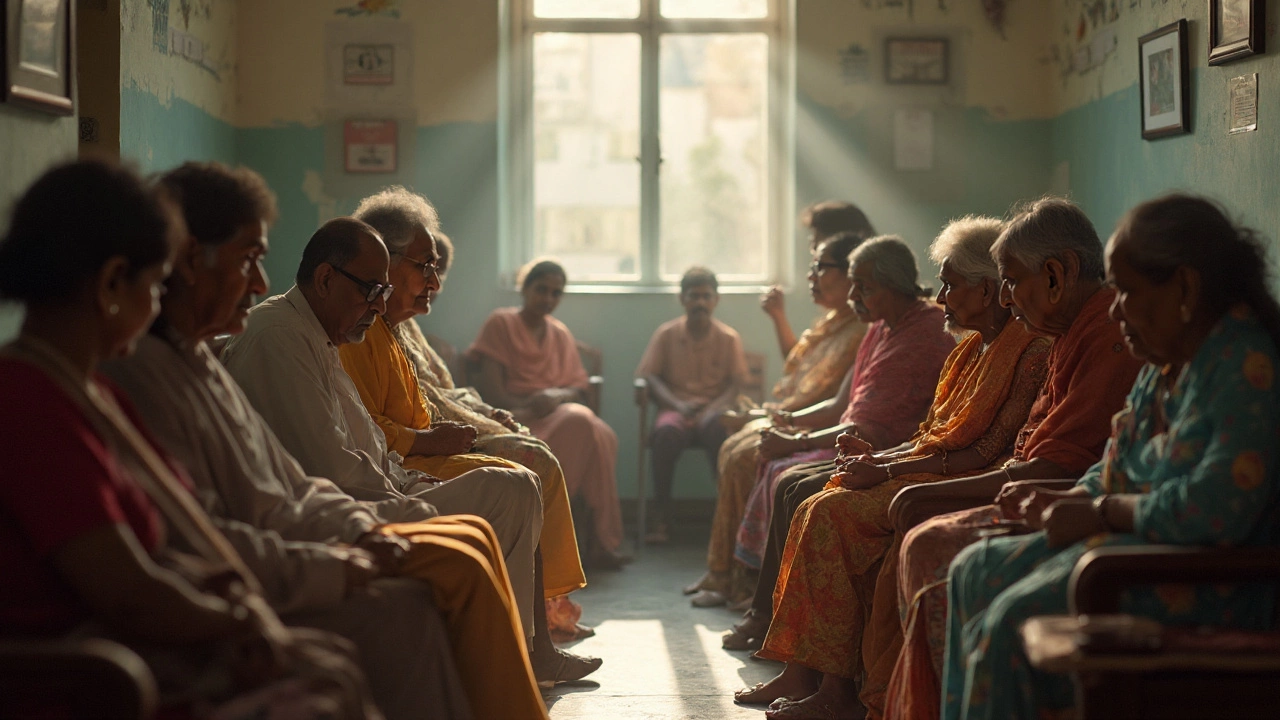You can take care of your body, you can eat all the right foods, and still, a lightning bolt can strike. Some cancers don’t give you time to fight—they move so fast you barely see them coming. Being hit with the news that you have cancer is hard enough. But imagine hearing yours is the "most aggressive" type. That phrase alone packs a punch scarier than most diagnoses. So, which cancer holds that title? It turns out, a few heavy hitters compete for this grim crown. The most notorious are pancreatic cancer and glioblastoma, with small-cell lung cancer trailing close behind. Let’s break down what sets them apart from the rest—and why their reputation makes so many oncologists nervous.
What Makes a Cancer "Aggressive"?
Aggressiveness isn’t just about growing fast, though speed is a big part of it. When doctors call a cancer aggressive, they mean it spreads quickly, resists treatment, and doesn’t go easy on the body. One of the main things they look for is how fast the tumor cells divide. The technical term is "mitotic rate"—the higher this is, the more out-of-control the cancer becomes. Some cancers, like certain skin cancers, might grow outward and become massive but don’t spread much. They’re scary to look at but often easier to treat. But when you’ve got a cancer that silently takes over the body, jumping from organ to organ, there’s no time to waste.
Let’s talk real numbers for a minute. A 2024 study from the American Cancer Society showed that the median survival time for untreated glioblastoma is just 3–4 months. Treated, it barely stretches beyond 14–16 months. Pancreatic cancer isn’t any kinder; after diagnosis, less than 12% of people are still around five years later. These aren’t outliers. This is exactly why doctors keep a keen eye out for these specific types, sometimes more than even advanced breast or colon cancers. Pancreatic and brain cancers don’t play by the normal rules. They go undetected until they’ve set up camp in places you just can’t reach with a scalpel or a dose of radiation.
You might be surprised, but some of these tumors are also stubbornly quiet. They don’t always give dramatic warning signs. For instance, pancreatic cancer often whispers through vague symptoms like back pain, mild stomach discomfort, or fatigue—things we all brush off after a rough week. By the time more "classical" signs, such as yellowing skin (jaundice) or sudden weight loss, hit, the cancer has spread beyond the pancreas in over 80% of cases. Glioblastomas, meanwhile, can make a person seem clumsy, forgetful, or just a bit off mentally, which often gets chalked up to aging or stress.
So what makes a cancer aggressive? It’s the triple threat: rapid cell division, silent invasion, and the sheer ability to dodge the body’s natural defenses. If you were to plot a graph, the line would shoot up fast—relentlessly—and bring nasty surprises every step of the way.
Pancreatic Cancer: The Silent Killer
Here’s a blunt fact: Pancreatic cancer ranks as one of the deadliest cancers worldwide, sometimes called the “silent killer.” By the time you feel sick, the odds are stacked against you. Its main villainous trick? It flies under the radar, hiding in the deep recesses of your belly, surrounded by organs and nerves that make surgery tough. Most people don’t even know what their pancreas does (it helps you digest and controls blood sugar), so when it fails, you’re left with vague, nonspecific complaints.
In the U.S., the American Cancer Society reported around 65,000 new pancreatic cancer cases and estimated over 50,000 deaths from it in 2024 alone. The prognosis is brutal: Only about 1 in 10 people survive five years post-diagnosis. Compare that to breast cancer, where five-year survival rates are closer to 91%. It’s not that doctors aren’t trying. The real problem is early warning signs are practically invisible. Pain might only start when the tumor grows big enough to press against nerves or block the bile duct. Weight loss and new-onset diabetes are often missed, misattributed to other issues, or diagnosed too late. Family history, smoking, chronic pancreatitis, and obesity all spike your risk, but even people with no real risk factors can end up blindsided.
Detecting pancreatic cancer early is like searching for a needle in a haystack. Imaging tests like CT scans and MRIs help but aren’t perfect. There are no solid blood tests for the general public. A lot of researchers are laser-focused on this issue—early detection may give us a shot at better survival rates. For now, though, awareness is your best tool. If there’s ever sudden unexplained weight loss, back or abdominal pain that won’t quit, jaundice, or digestive changes, it’s better to nag your doctor than stay silent.
Treatment is tough and usually includes a combination of surgery, chemotherapy, and radiation—if the cancer’s still local. But pancreatic cancer tends to wrap itself around blood vessels, making surgery risky or impossible for many. Even when doctors manage to remove the tumor, microscopic cancer cells often remain, leading to recurrence. Newer treatments, like immunotherapies and targeted drugs, have shown some hopeful results in clinical trials, but we’re not at "miracle cure" status yet.
| Type of Cancer | 5-Year Survival Rate (2024) | Typical Age at Diagnosis | Common Symptoms |
|---|---|---|---|
| Pancreatic | 12% | 65–74 years | Back pain, jaundice, weight loss, new diabetes |
| Glioblastoma | 7% | 45–70 years | Headache, confusion, seizures, personality changes |
| Small-cell lung | 7% | 60–75 years | Cough, chest pain, shortness of breath |

Glioblastoma and Other Notorious Fast-Growers
If pancreatic cancer is the world’s stealth operator, glioblastoma is the demolition crew. This aggressive brain tumor doesn’t play fair—there’s no easy surgical roadmap as it festers inside the brain’s intricate folds. The average time from appearance to diagnosis is just months. Once doctors discover it, treatment begins immediately—usually surgery to remove as much as possible, followed by weeks of radiation and chemo. But these tumors almost always come back, often faster and deadlier.
Glioblastoma is sneaky in symptoms. Headaches aren’t always present, and when they are, they mimic regular migraines. Seizures in adults suddenly pop up, raising a red flag. Changes in mood, memory, or speech might seem like stress or part of aging. The disease often advances before anyone takes it seriously. The five-year survival rate is stuck at about 7%, with most patients not living beyond two years even with the best available care.
Other fast-track cancers deserve mention. Small-cell lung cancer, for example, grows and spreads at warp speed. It can double in size in as little as 25 days. Not only is it quick to move—it also responds to chemo but almost always returns, stronger than before. There’s also acute leukemia, both in kids and adults, especially acute myeloid leukemia (AML), with an explosive growth rate that overwhelms the blood in weeks. Testicular cancers and certain lymphomas also fall into the “aggressive but potentially curable” bucket—when caught early and tackled hard with the right drugs, they can be pushed into remission.
Researchers are racing to outsmart these cancers, but every year, thousands lose the fight simply because diagnosis came too late or the cancer mutated to resist every weapon in our arsenal. The race against time is real—and relentless.
Survival Rates, Risk Factors, and How to Spot the Warning Signs
Numbers tell a story that’s hard to ignore. Here’s the kicker: Even with new drugs and stats on the upswing for other cancers, these aggressive types haven’t really budged. In 2024, the five-year survival rate for pancreatic cancer in the U.S. sits at 12%. Glioblastoma holds at an even lower 7%, while small-cell lung cancer barely moves the needle. For comparison, melanoma, another potentially aggressive cancer, carries a five-year survival rate of 94% if caught early. The difference? Early detection and where the cancer sits in the body.
Who’s at risk? With pancreatic cancer, the biggest risk factors are age, smoking, heavy alcohol use, obesity, and chronic conditions like pancreatitis or diabetes. There’s also a genetic link—those with a family history or inherited genetic syndromes, like BRCA mutations, stand a higher chance. But for glioblastoma, the field is murkier. While no clear lifestyle risk, exposure to radiation and certain rare inherited disorders push up the odds slightly. Small-cell lung cancer is almost always tied to a history of heavy smoking.
- Unexplained, persistent symptoms (pain that lasts weeks, sudden confusion, weight loss)
- New onset diabetes after age 50—especially if you don’t fit the usual risk profile
- Memory changes, confusion, or unexplained headaches
- Dark urine or pale stool, especially with yellow skin or eyes (jaundice)
- Sudden onset of seizures, especially in adults with no previous history
You don’t need to panic with every new ache, but don’t ignore symptoms that linger—and don’t let your doctor ignore them either. Studies show that earlier detection means better odds, even when the cancer is aggressive. Some new blood tests for "circulating tumor DNA" are under study, which may help sniff out hidden cancers sooner in the near future.
Lifestyle tweaks do play a role. Cutting out tobacco, maintaining a healthy weight, limiting alcohol, and managing diabetes or chronic pancreatitis give you a fighting chance. But staying alert to new, unusual symptoms remains the best self-defense tool we have until those screening breakthroughs finally get to us.
